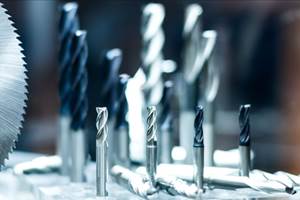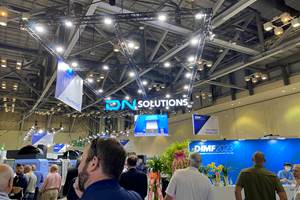Minimizing Work From Job To Job
Setup reduction has been a hot topic for several years. Everyone wants to reduce downtime between production runs, and companies go to great lengths to achieve this goal.
Share





Setup reduction has been a hot topic for several years. Everyone wants to reduce downtime between production runs, and companies go to great lengths to achieve this goal. Sometimes we're so wrapped up in the complex issues related to setup reduction that we ignore some very simple points. Here are a few.
Program the mean value of every tolerance band for every job. If you do, offset adjustments for tools used in the job just run will still be correct for those tools still needed in the next job.
I've seen some programmers who will program whatever value comes directly from the CAD drawing (often a nominal value, not the mean value of the tolerance band). Or the programmer may program the target value for the dimension, which is often close to the high or low limit. This can lead to great confusion and frustration at the machine during setup when the setup person is sizing the first workpiece in the production run. Every offset for every tool must be readjusted for every job.
Specify target values for every dimension. Many programmers leave it completely to setup people to determine target values for dimensions being machined. Though determining target values may be a relatively simple task, it can be time consuming, especially if the job is going to be turned over to a lesser-skilled operator, and if the setup person must mark up a print to include every target dimension. Note that because determining target dimension can be somewhat subjective, this can also lead to inconsistencies from one time a job is run to the next. The programmer should provide target dimensions as part of the setup and production run documentation.
Include program zero assignment values in the program. For machining center applications, if you are using vises, fixtures and/or other workholding devices that locate in dowel holes or keyways in the machine table, your setup people should not be using edge finders or dial indicators to locate the program zero point every time the setup is made. If setups are qualified, the program zero assignment values (placed in what are commonly called fixture offsets) will remain the same every time the job is run. For most controls, these values can be included in the program, eliminating the need for the setup person to measure or enter them.
Take advantage of standard tools. Most companies have a certain number of cutting tools that are used on a very regular basis. For those tools used most often, assign a permanent tool station in the machine. For lesser used tools, or with machines that have a limited number of tool stations, keep them permanently assembled and available for immediate use. I've seen companies that use a tool storage rack as a kind of extension of their CNC machine's tool magazine or turret. Whenever a tool is needed, it is readily available.
Program offset settings whenever possible. Some companies use special tool measuring devices to determine and program all tool length and cutter radius compensation values prior to setup. Not all companies can justify the purchase of such devices. Even so, programmers in all companies should be on the lookout for offset settings they know as the program is being written. Why force a setup person to enter an offset value during setup if it's known when the program is written? With tool nose radius compensation on turning centers, for example, the programmer commonly specifies the nose radius for tools to be used. If the programmer knows this value, he or she can include the offset setting command right in the program.
Be consistent! As you know, many programming functions can be handled in two or more ways. Cutter radius compensation is just one example of the many features that can be programmed with two popular methods that have implications related to how setups are made. Yet you may have programmers in your company who disagree on the method that's best. If each programs with the method he or she feels is best, setup people will be constantly struggling from job to job. Again, this is just one example of inconsistencies that lead to unnecessary wasted time during setup.
Watch your setup people. What can be done to minimize work from one setup to the next? You may have consistencies among workpieces that make it easy to design multiple-purpose workholding tooling. You may be able to schedule jobs that minimize work during setup without jeopardizing your just-in-time principles. You may be able to minimize wasted time through better organization. But you won't know it unless you are aware of what your setup people are doing.
Related Content
How I Made It: Amy Skrzypczak, CNC Machinist, Westminster Tool
At just 28 years old, Amy Skrzypczak is already logging her ninth year as a CNC machinist. While during high school Skrzypczak may not have guessed that she’d soon be running an electrical discharge machining (EDM) department, after attending her local community college she found a home among the “misfits” at Westminster Tool. Today, she oversees the company’s wire EDM operations and feels grateful to have avoided more well-worn career paths.
Read MoreManufacturing Madness: Colleges Vie for Machining Title (Includes Video)
The first annual SEC Machining Competition highlighted students studying for careers in machining, as well as the need to rebuild a domestic manufacturing workforce.
Read MoreAddressing the Manufacturing Labor Shortage Needs to Start Here
Student-run businesses focused on technical training for the trades are taking root across the U.S. Can we — should we — leverage their regional successes into a nationwide platform?
Read MoreDN Solutions Responds to Labor Shortages, Reshoring, the Automotive Industry and More
At its first in-person DIMF since 2019, DN Solutions showcased a range of new technologies, from automation to machine tools to software. President WJ Kim explains how these products are responses to changes within the company and the manufacturing industry as a whole.
Read MoreRead Next
5 Rules of Thumb for Buying CNC Machine Tools
Use these tips to carefully plan your machine tool purchases and to avoid regretting your decision later.
Read MoreBuilding Out a Foundation for Student Machinists
Autodesk and Haas have teamed up to produce an introductory course for students that covers the basics of CAD, CAM and CNC while providing them with a portfolio part.
Read MoreSetting Up the Building Blocks for a Digital Factory
Woodward Inc. spent over a year developing an API to connect machines to its digital factory. Caron Engineering’s MiConnect has cut most of this process while also granting the shop greater access to machine information.
Read More
.jpg;width=70;height=70;mode=crop)






























